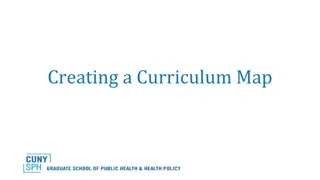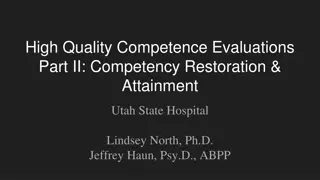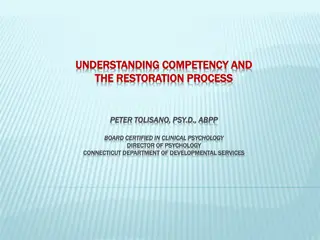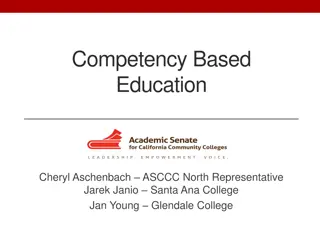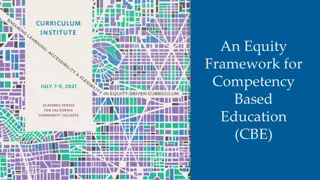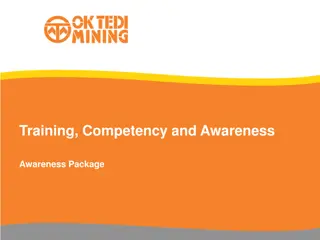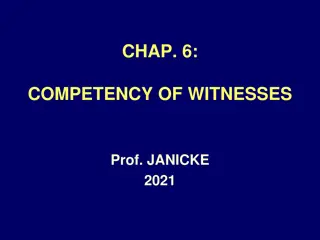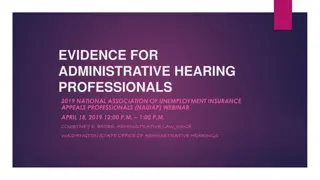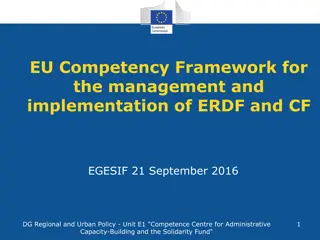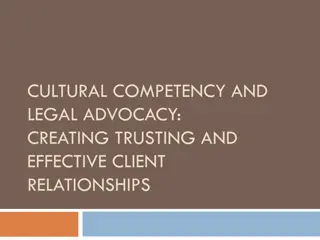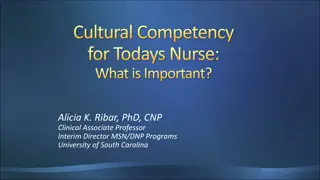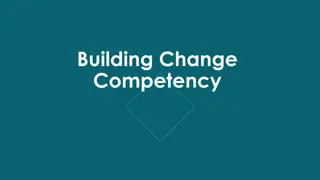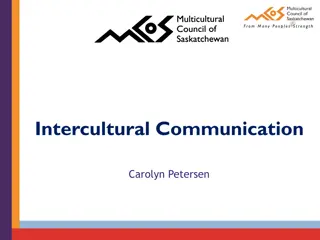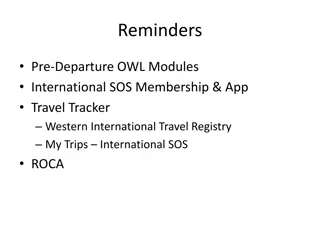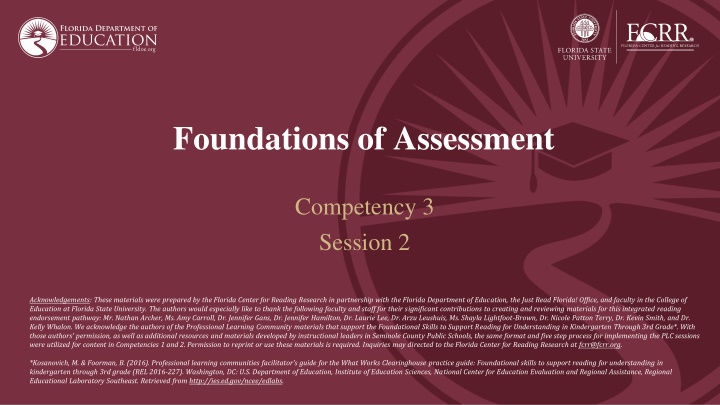
Foundations of Reading Assessment and Instruction
This course module focuses on the foundations of assessment in literacy/reading, emphasizing research-based reading instruction. It covers competencies for the Florida Reading Endorsement, guiding teachers in implementing assessments, analyzing data, and selecting appropriate interventions. The module explores purposes for assessment such as screening, diagnostic, and progress monitoring, highlighting the importance of ongoing assessment practices.
Download Presentation

Please find below an Image/Link to download the presentation.
The content on the website is provided AS IS for your information and personal use only. It may not be sold, licensed, or shared on other websites without obtaining consent from the author. If you encounter any issues during the download, it is possible that the publisher has removed the file from their server.
You are allowed to download the files provided on this website for personal or commercial use, subject to the condition that they are used lawfully. All files are the property of their respective owners.
The content on the website is provided AS IS for your information and personal use only. It may not be sold, licensed, or shared on other websites without obtaining consent from the author.
E N D
Presentation Transcript
Foundations of Assessment Competency 3 Session 2 Acknowledgements: These materials were prepared by the Florida Center for Reading Research in partnership with the Florida Department of Education, the Just Read Florida! Office, and faculty in the College of Education at Florida State University. The authors would especially like to thank the following faculty and staff for their significant contributions to creating and reviewing materials for this integrated reading endorsement pathway: Mr. Nathan Archer, Ms. Amy Carroll, Dr. Jennifer Gans, Dr. Jennifer Hamilton, Dr. Laurie Lee, Dr. Arzu Leushuis, Ms. Shayla Lightfoot-Brown, Dr. Nicole Patton Terry, Dr. Kevin Smith, and Dr. Kelly Whalon. We acknowledge the authors of the Professional Learning Community materials that support the Foundational Skills to Support Reading for Understanding in Kindergarten Through 3rd Grade*. With those authors' permission, as well as additional resources and materials developed by instructional leaders in Seminole County Public Schools, the same format and five step process for implementing the PLC sessions were utilized for content in Competencies 1 and 2. Permission to reprint or use these materials is required. Inquiries may directed to the Florida Center for Reading Research at fcrr@fcrr.org. *Kosanovich, M. & Foorman, B. (2016). Professional learning communities facilitator s guide for the What Works Clearinghouse practice guide: Foundational skills to support reading for understanding in kindergarten through 3rd grade (REL 2016-227). Washington, DC: U.S. Department of Education, Institute of Education Sciences, National Center for Education Evaluation and Regional Assistance, Regional Educational Laboratory Southeast. Retrieved from http://ies.ed.gov/ncee/edlabs.
Purpose of this Module This course provides a foundation in assessment with an emphasis on literacy/reading and is required for the Florida Reading Endorsement (Competencies 3) Grounded in the principles of research-based reading instruction and the Reading Endorsement Guiding principle that teaching reading for understanding is an ongoing systematic, problem solving process, teachers will implement and analyze assessments, and select appropriate instruction/interventions based on the collected data.
Purposes for Assessment Screening Diagnostic Progress Monitoring Brief, frequent, ongoing assessment Outcomes Brief measures designed to identify learner(s) in need of additional supports or instruction Typically administered when screening measures identify a need Used to determine if students reach mastery Used to determine if instruction or intervention are working, student is making progress toward goals, rate of progress Often used to make high stakes decisions including grade promotion and accountability Used to create an informed instructional plan Often administered universally 2-3 times a year
Two Categories of Assessment Formative Assessing to make decisions about teaching and learning Is instruction effective? Are students learning? Summative Evaluate effectiveness of instruction Evaluate what students have learned
Type of Assessments Informal Typically non-standardized Assess progress toward learning goals Allow greater flexibility Most frequently used to make daily instructional decisions Formal Typically standardized Compare individual performance to a group or criteria to identify specific strengths and/or areas of need Follow a prescribed process for administration and scoring
Type of Assessments Criterion-Referenced Compare individual scores to a predetermined criterion or benchmark These measures can include norm groups, but often focus on mastery learning Examples include curriculum based measurement, informal reading inventories Norm-Referenced Compare individual scores to that of the norm group These measures often include multiple norm groups (e.g., gender, age and grade norms) These tests produce derived scores including standard scores and percentile ranks Examples include commercially available standardized tests
Lets Review Based on the video, explain how you may use various reading assessments for the following purposes: Screening Diagnostic Progress Monitoring Outcomes Consider Eve: Eve s teacher administered a classwide assessment and found that Eve has scored below expected levels. She has a general idea of Eve s reading skills, but wants to learn a bit more about Eve s current strengths and areas of need. What was the purpose of the classwide assessment? Related to assessment, what should Eve s teacher do next? How should Eve s teacher use the information gathered from this assessment?
Interpreting Norm Referenced Tests Scores of Relative Standing Tell us percentage or proportion of students who earned better or worse scores Highly comparable because they mean the same thing regardless of age or content tested Used to compare performance on several tests Compare several people on the same test Examples include standard scores and percentile ranks Scores recommended by professional organizations Developmental Scores Based on average performance of individuals Age and grade equivalents Professional organizations suggest we DO NOT report these scores because they are easily misinterpreted (e.g., American Psychological Association, International Reading Association, Council for Exceptional Children) "Your child performed the same as a 9.2 year old." This is inaccurate. Why?
A Few Example Problems with Developmental Scores (Sylvia et al., 2017) Systematic Misinterpretation Achieving the same number correct as an older/younger child does not mean the child being tested performed in the same way Estimates based on data from the norm group These scores are estimates based on the norm group For example, a student may get age equivalent score of 4.1 when the norm sample does not include children under age 5 Typological Thinking There is no such thing as the average X-year old. These scores are based on a range and represents the middle 50 percent. Implication of a False Standard of Performance In the norm group, 50 percent of students tested scored below the median
Turn to a partner. Explain the purpose of a norm-referenced test using information in the video. Interpreting Norm-Referenced Tests Raw scores are converted to scores of relative standing to determine how students performed compared to a norm sample of same age or grade peers These scores tell us to what extent an individual s raw score differs from a norm group of same age/grade peers Salvia et al., 2017
Example of a distribution from a norm-referenced standardized test with a mean of 100 and standard deviation of 15 96% What percentage of learners will score 1. within two standard deviations of the mean? 2. within the mean or average range? 68% 34% 34% 14% 14% 2% 2% -1SD = 85 +1S = 115 +2S = 130 -2SD = 70 X = 100
Interpreting Standard Scores and Percentile Ranks Standard Score Percentile Rank Ron scored 85 on a measure with a mean of 100 and SD of 15 Ron scored one standard deviation below the mean or below average for his grade Sue achieved a percentile rank of 25 Sue scored the same or better than 25 percent of the people in the norm sample in her grade Which is easier to interpret? Why?
Your Turn to Interpret Standard Score and Percentile Rank Standard Score and Percentile Rank Ally s scores on the Woodcock Johnson Test of Achievement Letter Word Identification Subtest (Mean 100 and Standard Deviation 15) Standard score = 83 Percentile Rank = 10 Carlos scores on the Woodcock Johnson Test of Achievement Letter Word Identification Subtest (Mean 100 and Standard Deviation 15) Standard score = 98 Percentile Rank = 46




